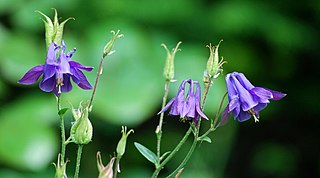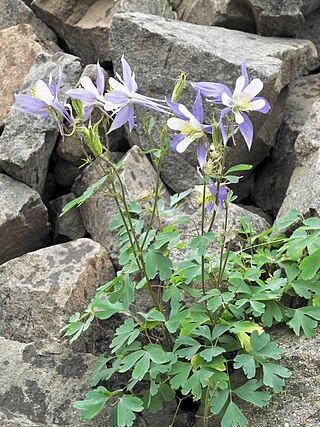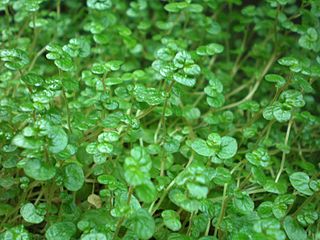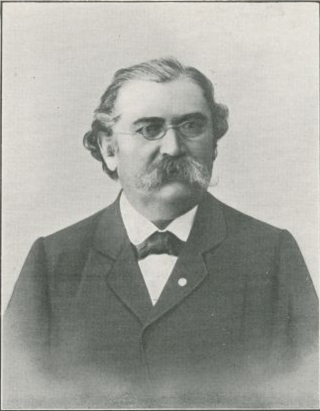
Aquilegia is a genus of about 130 species of perennial plants that are found in meadows, woodlands, and at higher elevations throughout the Northern Hemisphere, known for the spurred petals of their flowers.

Aquilegia canadensis, the Canadian or Canada columbine, eastern red columbine, or wild columbine, is a species of flowering plant in the buttercup family Ranunculaceae. It is an herbaceous perennial native to woodland and rocky slopes in eastern North America, prized for its red and yellow flowers. It readily hybridizes with other species in the genus Aquilegia.

Aquilegia coerulea, the Colorado columbine, Rocky Mountain columbine, or blue columbine, is a species of flowering plant in the buttercup family Ranunculaceae, native to the Rocky Mountains and some of the surrounding states of the western United States. It is the state flower of Colorado. The Latin specific name coerulea means "sky blue".

Soleirolia soleirolii is a flowering plant in the nettle family. It has a number of common names, including baby's tears, angel's tears, peace in the home, bits and pieces, bread and cheese, Corsican creeper, Corsican curse, friendship plant, mind-your-own-business, pollyanna vine, Paddy's wig, and mother of thousands. It should not be confused with Kalanchoe daigremontiana, another plant known as mother of thousands.

Corsica is an island in the Mediterranean Sea and one of the 18 regions of France. It is the fourth-largest island in the Mediterranean and lies southeast of the French mainland, west of the Italian Peninsula and immediately north of the Italian island of Sardinia, the nearest land mass. A single chain of mountains makes up two-thirds of the island. As of January 2024, it had a population of 355,528.

Aquilegia barbaricina, common name Barbaricina columbine, is a perennial species of flowering plant in the family Ranunculaceae. It is endemic to Italy, occurring only on the island of Sardinia.

John Isaac Briquet was a Swiss botanist, director of the Conservatoire Botanique at Geneva.

Aquilegia flabellata, common name fan columbine or dwarf columbine, is a perennial herbaceous flowering plant in the family Ranunculaceae, native to North and East Asia.

Aquilegia pyrenaica, common name Pyrenean columbine, is a species of flowering plant in the family Ranunculaceae. It is endemic to the Pyrenees where it grows on grassland and in rocky places. It was first described in 1805 by Augustin Pyramus de Candolle who gave it the name Aquilegia pyrenaica.

Esprit Requien was a French naturalist, who made contributions in the fields of conchology, paleontology and especially botany.

Julien Foucaud was a French botanist.

Aquilegia barnebyi, commonly known as the oil shale columbine or Barneby's columbine, is a perennial species of flowering plant in the buttercup family, with a native range comprising northeastern Utah and northwestern Colorado in the United States. It is named after Rupert Charles Barneby, who, with Harry Dwight Dillon Ripley, first discovered it in Colorado.

Aquilegia sibirica, the Siberian columbine, is a species of flowering plant in the family Ranunculaceae native to the north-central Asian regions of Siberia, northern Mongolia, Kazakhstan, and Xinjiang. A hardy perennial plant, it prefers temperate environments. The Siberian columbine can be between 1 foot (0.30 m) and 2 feet (0.61 m) tall with flowers that are lilac-blue and white in color.

Aquilegia bernardii, common name Bernard's columbine, is a perennial species of flowering plant in the family Ranunculaceae, endemic to Corsica.

Aquilegia desertorum, the desert columbine, is a perennial species of flowering plant in the family Ranunculaceae, native to the southwestern United States.

Aquilegia dinarica, the Dinaric columbine, is a perennial species of plant in the family Ranunculaceae, endemic to the Dinaric Alps of northern Albania, Bosnia and Herzegovina, Croatia, and Montenegro.

Aquilegia einseleana, or Einsele's columbine, is a perennial species of plant in the family Ranunculaceae, endemic to the central and eastern Alps of Slovenia and small areas of Germany, Austria, and Italy. Aquilegia einseleana grows to 45cm. It has blue-violet flowers which appear from May to September. The species was described by the German botanist Friedrich Wilhelm Schultz (1804–1876) in 1848, and named after his friend Dr. August Max Einsele (1803–1870), a Bavarian physician and botanist. Einsele's columbine grows in grassy and rocky limestone areas at altitudes between 600m and 1800m.

Aquilegia glandulosa, the Siberian columbine, is a perennial species of plant in the family Ranunculaceae, native to northern and central Asia.
Aquilegia incurvata, or the Qinling columbine (秦岭耧斗菜), is a perennial species of plant in the family Ranunculaceae, endemic to the Qinling mountain range in China.

Aquilegia jonesii, or Jones' columbine, is a perennial species of plant in the family Ranunculaceae, endemic to Alberta, Montana, and Wyoming.


















